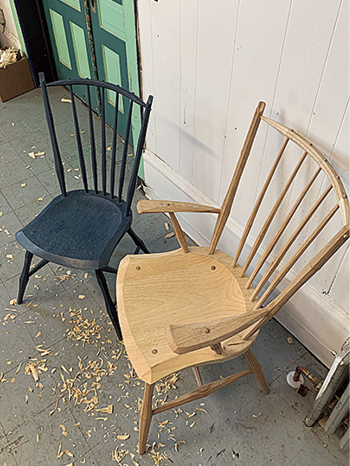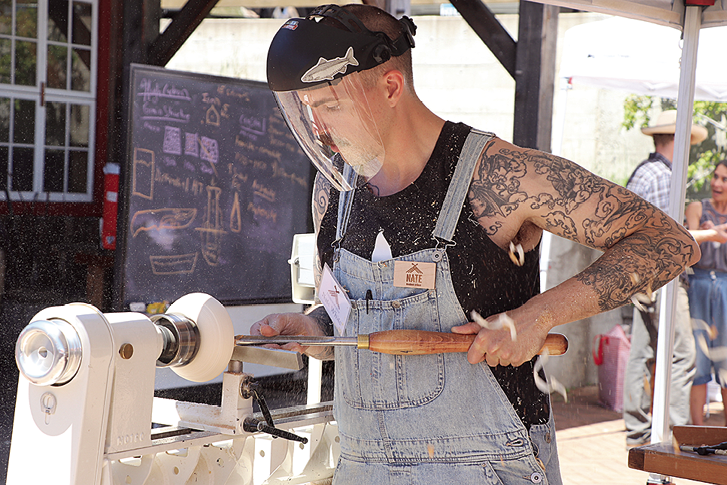In the past two months, between Wood Week and a trip I took through the Artisan Development Program at North House Folk School, I was able to spend time with some notable woodworkers and learn not only technical skills, but also new approaches to woodworking.
In February I was in Jonesborough, Tenn., working with chairmaker Curtis Buchanan. He guided me on making his design for the democratic armchair as he tested out new plans for a settee version. The democratic armchair is a simple Windsor chair that we predominantly used hand tools to make. Its name is a nod to the late Bill Coperthwaite, an academic who coined the term “democratic tools.” Despite having a PHD from Harvard, Coperthwaite believed in living simply and spent a lot of his life studying nomadic tool use. He was opposed to overly complicated or hyper specific tools that lessened people’s agency to build or create things, or tools that would “tie you to a workbench.” With Buchanan’s chair, he emphasized that you can do much of the shaping with just a drawknife—he really tries to use the smallest amount of the simplest, cheapest tools possible. I was drawn to making the chair because Buchanan does a remarkable job of combining curves and facets with great resolution where they meet. The seat and arms are quite sculptural, while the other pieces—the spindles, legs, stretchers, and posts—are all octagonal, with subtle arcs and tapers. It was a valuable experience to work with Buchanan and I’m extremely grateful for it; finding someone to work with one-on-one like that is rare, especially someone as accomplished as him.
Chairmaking has always been something that I found equally interesting as it is daunting. Learning certain technical aspects of each process was great, but one thing that really stuck with me was more about general approach and practice. When we were working on the arms, Buchanan brought up how he approached making his chairs. He said that he tries to avoid thinking of the pieces as things that he needs to get done. Instead, he tries to focus on each individual cut. Sure, he had to keep track of how many spindles he had left to make, but instead of rushing through each one, he would try and block out how many he had left, or what time it was, and try to be very intentional with each pull of his drawknife—each cut as important as each piece. Using this approach has kept me centered and lets me achieve a better focus on my work.

Wood Week just wrapped up at North House and as a part of that, I assisted with Kenneth Kortemier’s class on tramp art. Kortemier is a longtime friend and mentor of mine, and was an instructor at the Carpenter’s Boat Shop, a wooden boat shop in Maine, where I got my first introduction to woodworking in 2011. Tramp art is a bit of a misnomer, but it is an American folk art that started around the Great Depression, fading out of practice in the 1970s. It was predominantly found in areas with high immigrant populations from northern Europe, so it can pop up quite regularly at flea markets and estate sales in the Midwest. There are two major forms, one is a type of notching on the edges of thinly cut stock, that then gets layers on top of each other. The layers get reduced in size equal to the thickness of the material, which gives it a pyramid effect. The stock was typically made from discarded cigar boxes, which were quite common during the Civil War and onwards. The forms borrow heavily from Finnish-style birch boxes, of which Kortemier brought an example of that was made by his Finnish grandfather. Tramp art was made predominantly by the proletariat with what was in cheap (or free) abundance around them. Birch trees/bark, which would have been plentiful in rural Scandinavia, were replaced by cigar boxes and fruit crates of American cities. Most of the time, people used this technique to decorate other cigar boxes and they were often used to house personal treasures, or use as sewing boxes.
In Kortemier’s class, next to a diagram he had on the chalkboard, he had written, “Each cut as its own cut.” The cuts themselves are quite easy to do; just a series of small notched 45-degree cuts on the edge. The challenge is similar to knitting—first you work on a row, then as those rows stack up, they may form a sleeve, then another sleeve, and by the end of your project you have a sweater. I found the approach similar to Buchanan’s, being very intentional and focused on each smaller, simple movement and having that all add up into a complex final product.
Later at Wood Week, during a presentation by Barn Carder, he asked everyone about their craft practice. Kortemier elaborated about his technique and approach, saying that he had adapted it from his yoga practice. That when he’s in his shop or working on a project, he is also trying to break each process down into its simplest, smallest steps so he can put more intention into each one of them. It is an interesting idea, because I think a lot of people assume that once you master something, when it becomes rote, that it’s no longer a challenge; that you can go into “auto-pilot.” But one thing Buchanan emphasized was that after 40 years of making chairs, they still challenge him, and that’s why he’s been able to do it for so long. If there wasn’t a challenge, it would be mindless, tedious and something you dread. I find this similar to fishing. If you are zoning out and daydreaming, you’re probably going to miss bites. I think there is a specific place you need to enter in your mind where you are completely present in the moment of what you are doing, while also letting your tools become an extension of your hands, letting your experience guide you.
By Nate White






